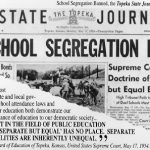Brown v Topeka Board of Education.

Brown v Topeka Board of Education – Newspaper Report
Linda Brown was a third grade student in a Black elementary school in Topeka. The school was over a mile from her home and she had to cross railways lines to get there. A Whie Elementary School was much closer to home, just 7 blocks away. Linda Brown’s father went to the National Assocation for the Advancement of Coloured People and asked for help when the principal of the white elementary school refused to accept Linda’s application. He wanted Linda to do well at school and wasn’t happy that she had to travel so far and across dangerous railway tracks, when there was a perfectly good school much closer to home.
The NAACP decided to challenge the decision and asked the courts to take out an injunction that would prevent the Board of Education from imposing this type of segregation. The court heard from manay expert witnesses, most f whom showed how detrimental for black pupils segregation was. However there was a precedent in law that provided for ‘equal’ but ‘segregated’ schools for white and black children (Supreme Court had not to this date overturned the ruling of Plessy v Ferguson). As a result the judges ruled that the segregation was legal: though there is evidence to suggest that they didn’t neccessarily agree with that!
The NAACP decided to take the Brown v the Topeka Board of Education case to appeal. They wanted the Supreme Court to make a judgement on whether or not segregation was legal.
The Supreme Court deliberated long and hard over the this issue. In 1954 they reached a unanimous decision. Chief Justice Earl Warren told the court:
“We come then to the question presented: Does segregation of children in public schools solely on the basis of race, even though the physical facilities and other “tangible” factors may be equal, deprive the children of the minority group of equal educational opportunities? We believe that it does…We conclude that in the field of public education the doctrine of ‘separate but equal’ has no place. Separate educational facilities are inherently unequal. Therefore, we hold that the plaintiffs and others similarly situated for whom the actions have been brought are, by reason of the segregation complained of, deprived of the equal protection of the laws guaranteed by the Fourteenth Amendment.”
In doing so the Supreme court had paved the way for mixed race schools. This did not happen overnight though.
Sources
Source: EXTERNAL LINK. Click on the thumbnail to go to the US National Archives website, where you can see a copy of the judges decision in the Brown v Topeka case.
Decision: Brown v Topeka
Source: Chief Justice Earl Warren, 1954
We come then to the question presented: Does segregation of children in public schools solely on the basis of race, even though the physical facilities and other “tangible” factors may be equal, deprive the children of the minority group of equal educational opportunities? We believe that it does…We conclude that in the field of public education the doctrine of ‘separate but equal’ has no place. Separate educational facilities are inherently unequal. Therefore, we hold that the plaintiffs and others similarly situated for whom the actions have been brought are, by reason of the segregation complained of, deprived of the equal protection of the laws guaranteed by the Fourteenth Amendment.
History of the United States in the Twentieth Century
America in the 1920s and 1930s
USA at the start of the 20th Century – Causes of the Economic Boom – Impact of Economic Growth in the 1920’s – Agriculture in the 1920’s – The “Roaring” Twenties – Prohibition – Ku Klux Klan in the 20’s – Causes of the Wall Street Crash – Consequences of the Wall Street Crash – The Great Depression – The New Deal – Opposition to the New Deal – Evaluation of the New Deal
The United States c1945-1971
The Red Scare – Impact of the Second World War on Civil Rights – Civil Rights in 1950 – Brown v Topeka Board of Education – Little Rock High School – Rosa Parks and the Montgomery Bus Protest – Martin Luther King Jnr – Nation of Islam and Malcolm X – The Black Panthers – Ku Klux Klan in the 1960’s – March on Washington – USA: Civil Rights Acts in the 1960s – Immigration Act of 1965 – Chicano movement and Civil Rights for Hispanic Americans – College Sit In’s and Student Protests – Women’s Rights – Native Americans and Civil Rights
